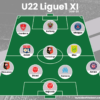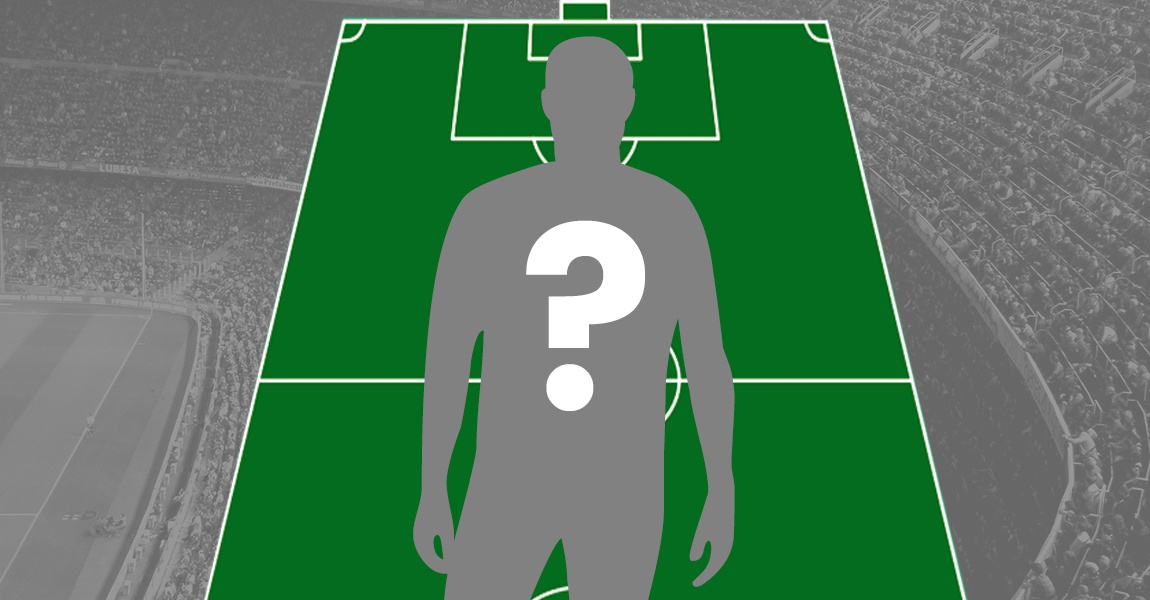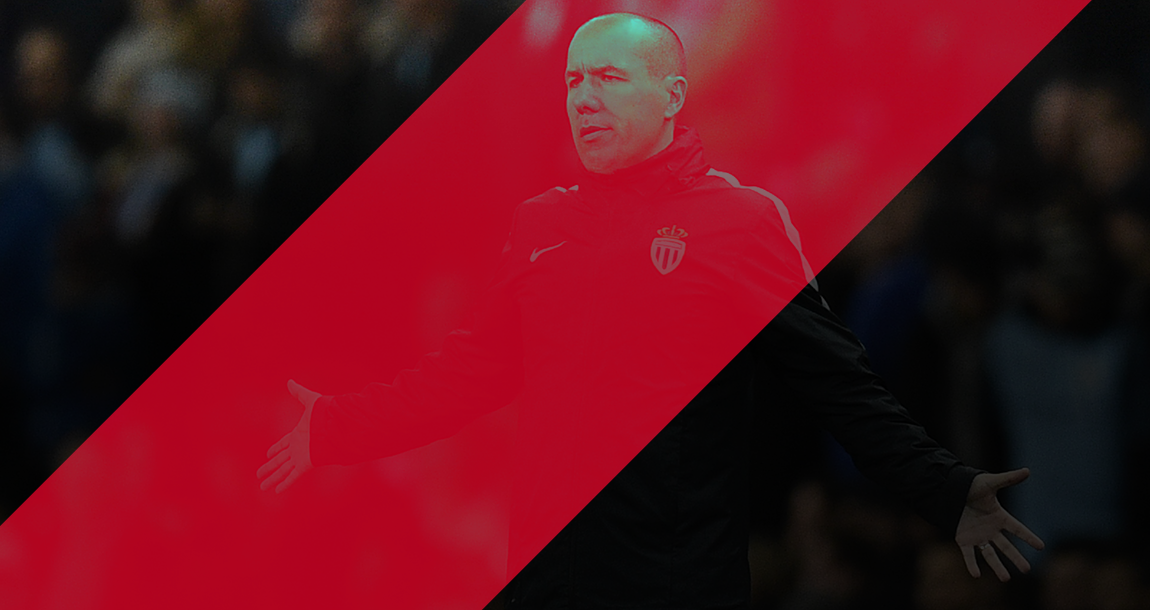Eric Devin writes a detailed tactical analysis of the Ligue 1 match that ended Monaco 3-0 Nice.
Neither the one-sided contest the final margin suggests, nor a decisive blow in the Ligue 1 title race, Monaco’s 3-0 victory over OGC Nice on Saturday afternoon nevertheless was an instructive encounter. Monaco, and Benjamin Mendy in particular, were at their rampaging best, and as Nice seek to regain their footing, they should take heart in displaying a good level of resilience, even if manager Lucien Favre could have perhaps shown a bit more inventiveness as regards his tactics.
As the blinding pace and dribbling ability of Ricardo Pereira was still a miss, and attacking midfielder Belhanda was only able to feature as a substitute in his recovery from a toe injury, Favre made some necessary adjustments to his preferred 3-5-1-1. The Swiss continued with three at the back, but, seeking to counter Monaco’s attacking firepower, he handed starts to Alassane Pléa and Mario Balotelli, with Valentin Eysseric on the opposite flank. In the prolonged absence of Paul Baysse, Nice had often played a 4-3-3, with Pléa used wide on the right; he and Balotelli could thus maintain a sense of continuity in their relationship. However, this also meant sacrificing numbers in midfield, with only Seri and Cyprien to battle against the energy of their Monaco counterparts.
Line Ups:

Made using TacticalPad
Pléa and Eysseric have unsung contributors to Nice’s strong start to the season, and their versatility had been a boon as Favre negotiated an injury crisis around the turn of the year. However, playing both with Balotelli left Nice short in midfield. Eysseric himself is only just back from an injury, but might there have been some logic to starting with the 4-3-3 that Nice eventually took up. The team would have enjoyed their customary domination of possession, and Seri and Cyprien could have done more to facilitate the attack. As it was, though, both Remi Walter and Vincent Koziello remained on the bench throughout, and Nice had a difficult time coping with the freedom of movement of Monaco’s wide players. The attacking proclivities of the two fullbacks, Mendy and Sidibé, similarly robbed Nice of much of their width, with both Pléa and Eysseric tucking inside as Dalbert and Souquet delivered decent performances without influencing the visitors’ attack.

Here, Nice show their opening formation and its inherent limitations. Monaco are in possession, but Nice are ill-suited to take advantage if the hosts misplace a pass. Cyprien and Seri sit very deep, so as to contend with Lemar and Silva tucking inside, and Dalbert is level with the two midfielders (yellow line). Eysseric and Plea, who in a three-man front line should be doing something to create width, not to mention guarding against the forays of Mendy and Sidibé, have also moved inside, seeking to put pressure on the midfield, but the net effect means that if Nice recover the ball, even with a numerical advantage in midfield, they are ill-suited to play on the counter.
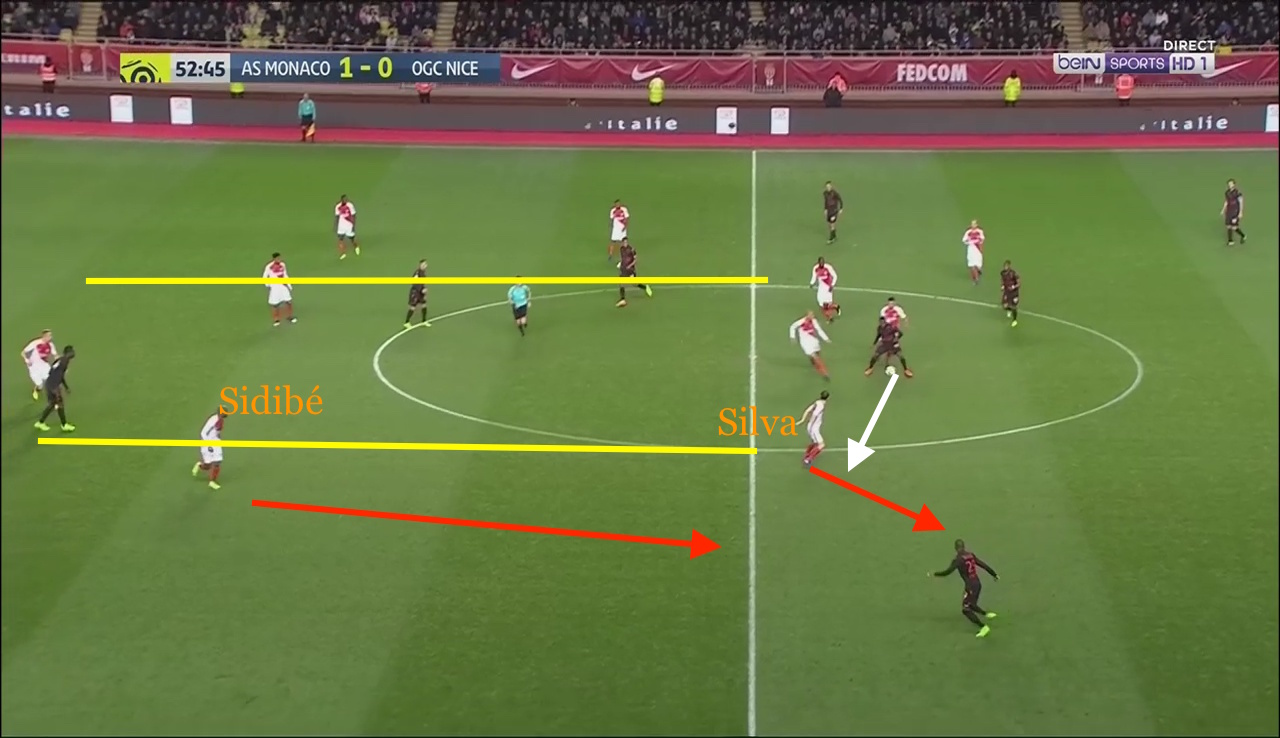
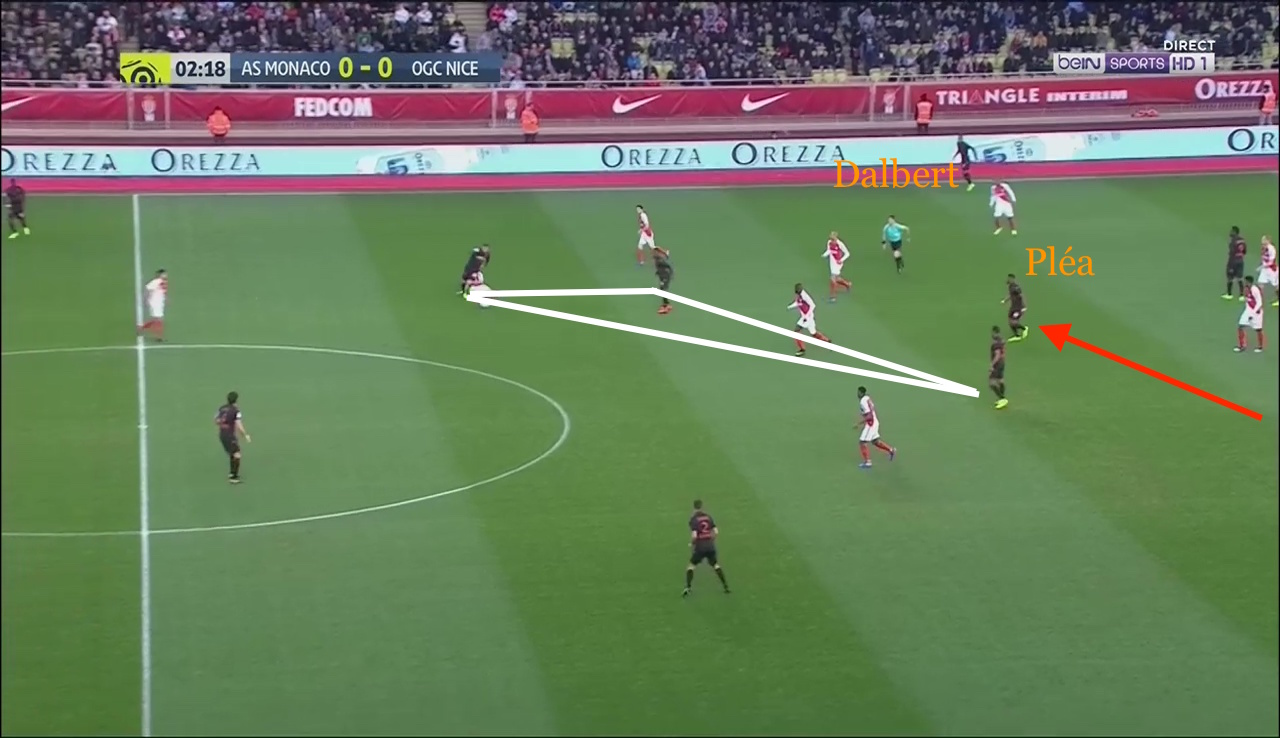
When Nice had possession, though, it wasn’t as though the situation improved, with their front three staying narrow. In their usual 4-3-3, Nice would play either with Pereira on the right and Pléa on the left, or with Arnaud Lusamba, an orthodox winger, on the left and Pléa on the right. However, Eysseric isn’t really a wide player; his style is closer to than of a no. 10, in that he has a tendency to drift inside. His instincts aren’t necessarily bad, as with Seri and Cyprien playing so deep, Nice lacked a creative threat to build play for Balotelli and Pléa. However, with Pléa also cutting inside in an attempt to draw defenders to free space for Balotelli, the front three too often found themselves occupying a similar space (yellow line). This allowed Monaco’s defense (orange box) to stay similarly compact, and with Nice’s wingbacks failing to provide any width, or any support from midfield, the front three were starved of any meaningful opportunities.
Eysseric, acting as the nearest thing to a playmaker, should have been able to shoulder more of the burden in this way, but as the second image shows, he was too often tasked with dropping deep to apply pressure to Silva. While his effort is to be lauded, the former Monaco man’s tracking back often saw Nice’s shape lost, as here, he functions as more of a third midfielder than a winger. Pléa, instead of establishing himself as an option to stretch play to the right, though, has persisted with cutting inside (red arrow), again leaving the visitors with a narrow shape overall. Thus, Monaco, whose high-octane style heavily relies on their endurance, could defend effectively with much less effort. Rather than being dragged all over the pitch, they could close down passing lanes and provide cover for each other without exhausting themselves.

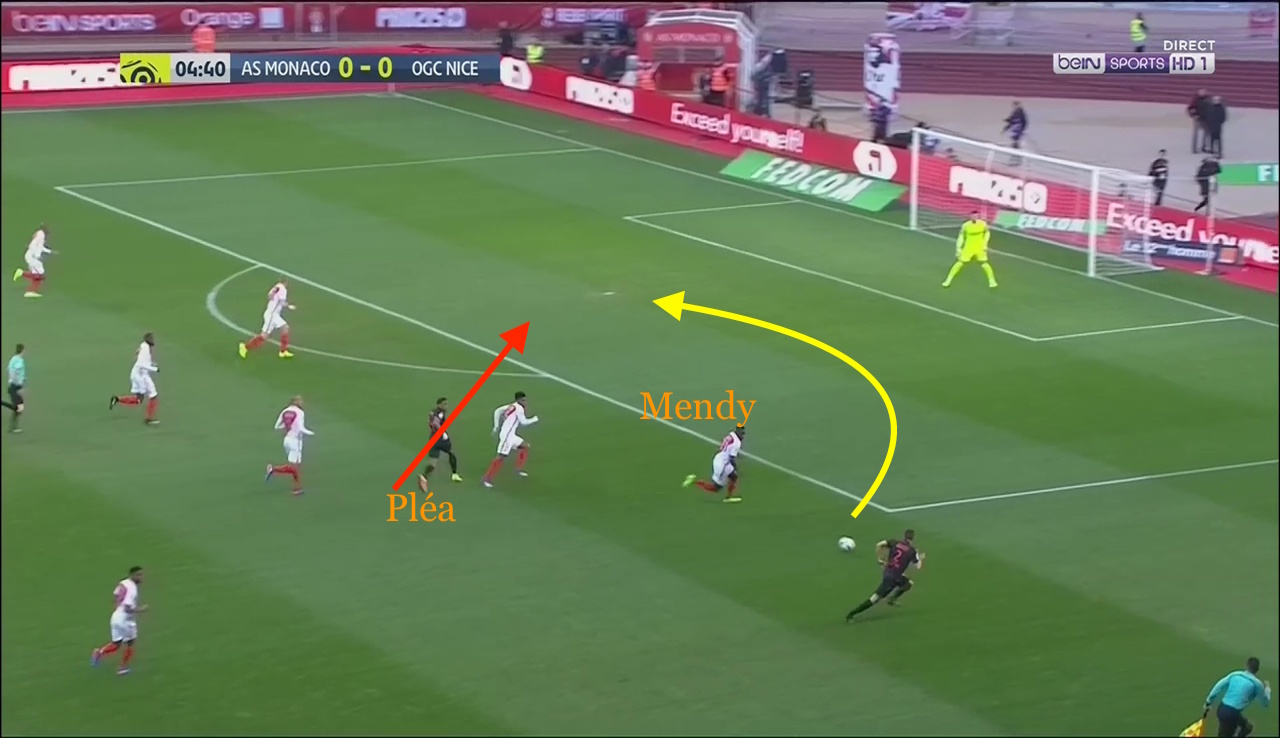
It wasn’t as though Monaco didn’t present Nice with opportunities to exploit them, though, particularly getting in behind the fullbacks. It was here, however, that Nice missed Pereira most dearly, through a combination of the style of play of Lemar and the inclusion of Mendy on the left flank. The Porto loanee’s replacement, Arnaud Souquet, is a player who can do a job, a consummate professional, but at this level, he is better used as a squad player, and this pair of images is a good illustration of that. Thomas Lemar is a supremely talented player, but he functions as more of an inverted winger than a truly creative player, not being quite as comfortable with the ball at his feet as Silva on the opposite flank. Thus, when Monaco lost the ball in wide areas, giving Nice a chance to play on the counter, it was more often on Les Aiglons’ right side.
Normally the province of Pereira and his combination of directness and pace, these opportunities instead fell to Souquet, who can be a prosaic right back, but isn’t quite inventive enough to be effective playing ahead of a three-man defense. In the first image, as Nice seek to get upfield quickly, he gives chase to a ball played over the top for him (red arrow). Cyprien is inside him, with Pléa just ahead; Balotelli lurks even further forward, and it seems a perfect counterattack is brewing, given that is actually some semblance of spacing among Nice’s attackers. Souquet plays a couple passes with Cyprien, continuing his run and peeling away from goal, in the second image. Mendy has stayed narrow and struggles to move to cover Souquet, but centrally, Monaco’s other defenders find time to organize themselves and track the run of Pléa. Where Pereira would have been more direct, running with the ball at his feet, it has taken Souquet, by dint of needing several passes to advance, far too long to get upfield in a dangerous position, and the chance to create something on the counter has gone begging.
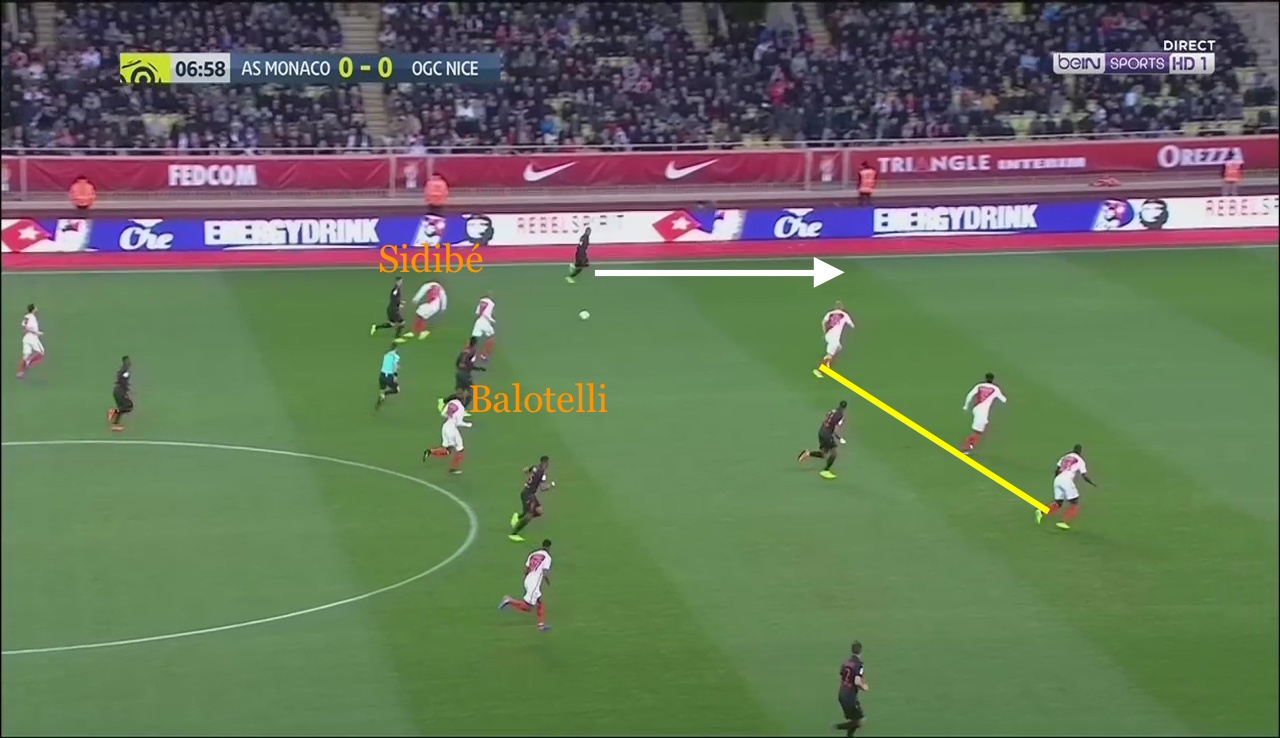
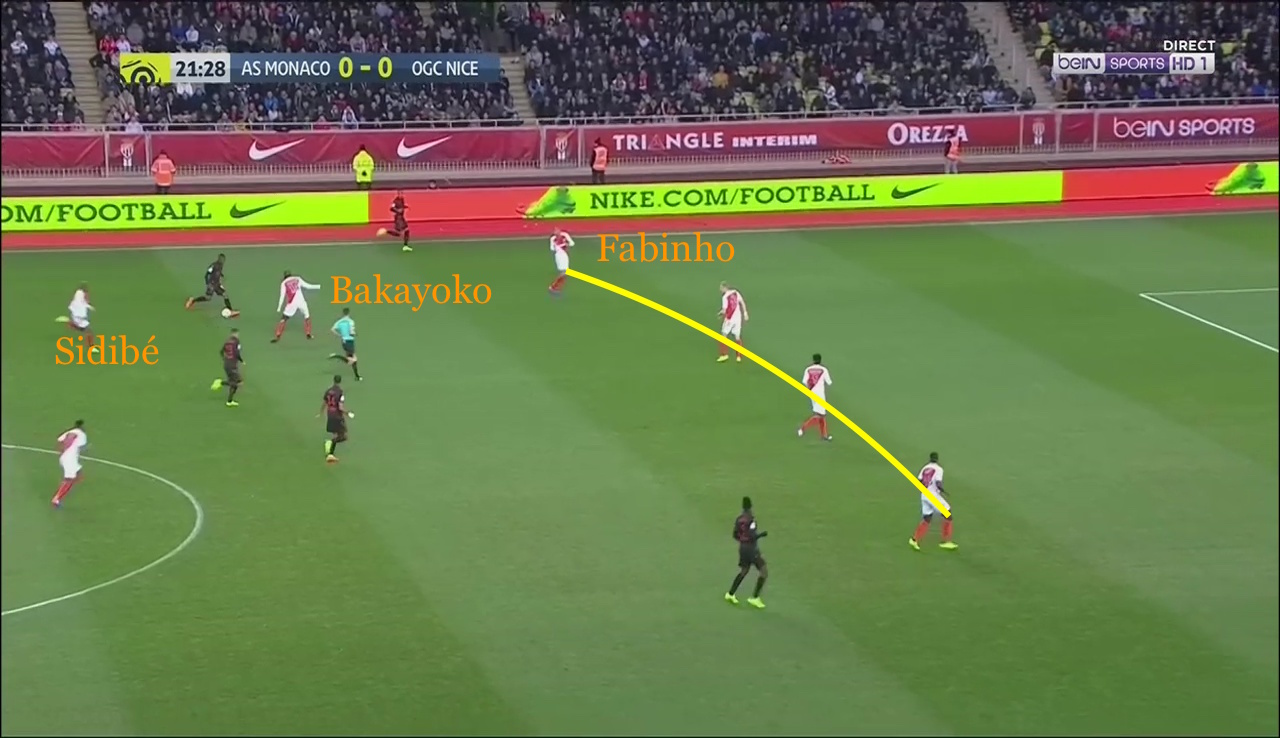
There were opportunities on the left as well for Nice, but here their frustration was down more to the ability of Fabinho to cover the blushes of Sidibé. While he has been used most often in central midfield this season, the Brazilian was first used at right back upon arriving at Monaco, and can comfortably slot over to allow Sidibé a bit more license in attack. In the first image, Sidibé has been caught in possession, and Dalbert is running with the ball in space (white arrow). Nice’s forwards, particularly Balotelli, are a bit slow to react, and Dalbert in this instance had to slow his run to wait for an opportunity to develop.
Nice may have regretted failing to take a chance, as the next image shows was more the order of the day. Sidibé has once again been caught in possession, and Seri (with the ball) looks wide to Dalbert to release the wing back. However, instead of being able to run into acres of space, he now faces a well-organized back line, with good spacing between the defenders laterally. Bakayoko has moved over to pressure the ball and Fabinho has dropped back to the right back position; Monaco may have lost the ball, but they still maintain their defensive shape. This allows the fullbacks to be a functional part of the attack, which, as the match wore on, became increasingly the clearest route to goal for Monaco.

I had said earlier that Thomas Lemar is less comfortable than Silva cutting inside with the ball at his feet. While this is true, it doesn’t mean that Lemar is totally ineffective playing closer to the strikers. Here, he has the ball at his feet on the counter, having already moved past Nice’s midfield. The back three (yellow line) have pulled away to the right, dragged by the runs of Falcao and Germain. Souquet is left with no other choice than to track the run of Lemar, leaving Mendy on his own on the overlap (red arrow). Monaco weren’t able to capitalize on this particular attack, but it was an ominous sign of how stretched Nice could be without a spare man in midfield.


Even when they did maintain a numerical advantage, though, Nice’s positional discipline was too often poor, as an examination of Monaco’s opening goal handily demonstrates. Admittedly, some of this was down to the vision and close control of Bernardo Silva, but Nice have failed to recognize the danger that could arise from a switch of play. Here, in the first image, Silva has the ball at his feet, with Sidibé gone beyond him. The right back’s movement has been tracked by Dalbert, which is well and good, but Malang Sarr has come out to challenge Silva on the ball. The teenager is a talented prospect, but he and Dalbert have failed to switch here, and he has thus become woefully out of position.
It should be noted, though, that this is not entirely his fault, as Eysseric, Seri and Cyprien all seem caught in two minds as to whether to double Silva. In the second image, Silva has played the ball back to Bakayoko, who can play the ball into the flat (white arrow) for Mendy (red arrow), or Lemar, who moves wide, hoping to pull another defender away from goal. Thus, Nice are caught on one side of the pitch, as indicated by the yellow line. Souquet has stayed back to defend with Baysse, and has to hustle to come close down the ball, which is picked up by Lemar.


Here, Pléa has tracked back to put pressure on Lemar, but Souquet, already scrambling to get into position, now is faced with the unenviable task of a foot race with Mendy, whose run is anticipated by the red arrow. Lemar has only to play a simple through ball (white arrow) to release Mendy into space, where the former Marseille man can swing in a cross toward a defense who will, like Souquet, be hastening to get into place to deal with the aerial threat presented by Germain and Falcao. In this last image, we see the end product of Silva’s quick switch of play. Mendy delivers a cross (yellow arrow), with Germain splitting the two defenders as Baysse is caught in no-man’s land and Sarr rushes to recover from having challenged Silva, having abandoned his mark. Mendy’s delivery is to be commended, as is Germain’s finish, but Silva’s intelligence and ability to draw the defense is the real catalyst here, sucking in Nice’s defense and then having the vision to make a quick change.
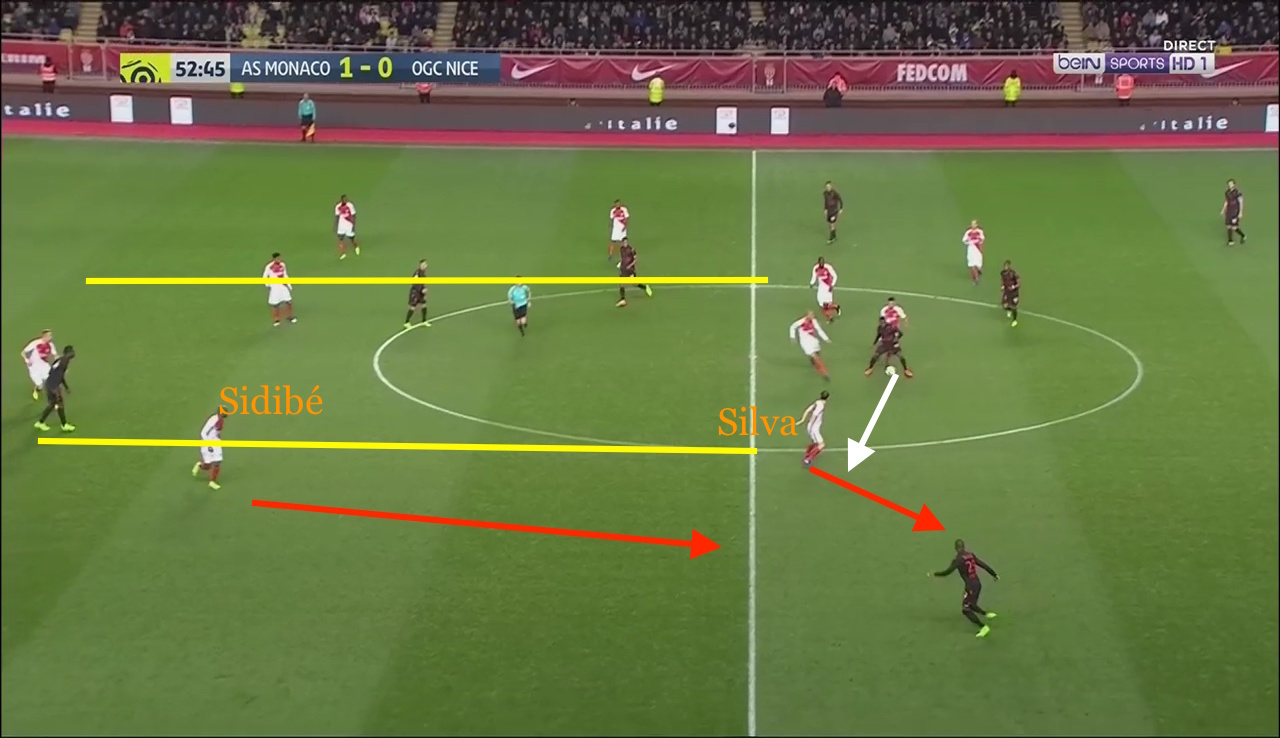
Nice attempted to respond to the goal, and credit should go to Lucien Favre’s team for not dropping their intensity, but they once again played into Monaco’s hands. In the first image, shortly after having gone behind, Nice are simply failing to spread play and stretch Monaco in any meaningful way. Balotelli, Eysseric and Pléa all stay within a space roughly the width of the center circle, indicated by the yellow lines. Seri (with ball) seeks to release Dalbert on the flank to give Nice’s attack some badly needed width, but because the front three are so close to each other, it is too easy for one of Silva or Sidibé to challenge the ball (red arrows), leaving the centre backs and midfielders to pressure Seri should he choose to play the ball back to his defense. It should be noted here that Falcao is the one pressuring Seri; Monaco deserve credit for defending with ten men, but Nice are making their task easy by failing to get their attacking trio into wide areas.

Nice soon went down two goals and in trying to respond, Favre removed the struggling Sarr for Belhanda, playing what amounted to a 4-2-1-3, with Cyprien, Seri and the substitute ideally taking turns to get forward. However, this only served to sow confusion, though, as neither Seri nor Cyprien seemed to have a clear idea of who should play deepest. The net effect was that the two played just as deep as they had in the first half, as shown in the first image. Souquet and Dalbert were able to get forward more, but that meant that Nice were forced to rely on a rusty Belhanda to be their prime creative outlet as they chased the match. The Dynamo Kiev loanee looked bright enough, and one wonders whether he might have had sixty minutes in him, rather than ninety.
Hindsight, though, is 20-20. Nice are an impressive team, and Favre an accomplished manager, but Monaco are a force of nature at present. Les Aiglons‘ title challenge continues apace, and a disappointing result can be seen as merely that, with so many matches yet to play. The hope here is that Nice can absorb these lessons and move forward, continuing their run for Champions’ League football. Favre has worked wonders to date, but combining a cadre of new arrivals in a variety of tactical systems is a difficult challenge, no matter the opponent. In-form Saint-Étienne await mid-week and with a strong response, the disappointment of Saturday can soon be naught but a memory.
Read all our tactical analyses here.





















































